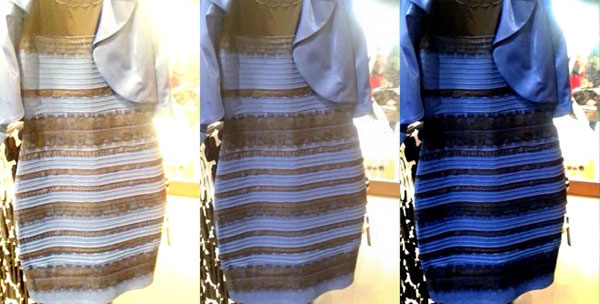Explain the color of the dress
A photo that can divide netizens around the world into two camps is no longer a strange thing. But in the past half a day, users across social media have been debating the photo of a bodycon dress.
The person who thought that the dress was green with black lace, said that the dress was white with gold lace. Neither side gives way to either side.
This controversy is not only a story about social media, but it is also related to primitive biology, and how the human eye and brain evolve to see and recognize colors in a world filled with light. sunshine.
Light enters the human eye through the lens, with different wavelengths corresponding to different colors. Light shines on the retina at the back of the eyeball, where the pigments form the nerve to the visual cortex - the part of the brain that processes these signals to form the image.
However, the first beam to reach our eyes is the wavelength of light illuminating the world, reflecting on what we are looking at. The brain does not go deep in analysis now, but understands which color light is reflected from the object, and basically eliminates that color from the 'true' color of the object.
'Our visual system automatically removes information about the color of light that is illuminating objects, and only receives information about light reflected from objects in reality,' said Jay Neitz, a neurologist. "But I have been studying individual differences in color perception for 30 years, and this is one of the biggest personal differences I've ever known," said the University of Washington student. " (Neitz sees white - yellow).

The dress is controversial.(Source: wired.com)
Often this system works effectively. But this photo has reached a certain visual boundary.One reason for this phenomenon is the design of the human brain. Humans evolved to be able to see objects in daylight, but daylight changed the colors of objects. The color axis of light changes from the pink red of dawn, to the bluish white of midday, and then returns to the red of the sunset.
'What's going on here is that your visual system is looking at the picture, and you're trying to reduce the color effect from the daylight ,' said Bevil Conway, a color research neurologist. sharpness and vision at Wellesley University. 'So people either remove the blue side and see the white-gold, or remove the yellow side and see the black-green color.' (Conway somehow sees blue and orange).
When the design team of Wired analyzed photos in Photoshop to give an answer to the controversy, they found that it was clear that the places where some people saw were green were indeed green. But this may be due to the background color, not the actual color.
'When looking at the RGB, R (red - red) values of 93, G (green - green) is 76 and B (blue - blue) is 50. If you just read these numbers and guess what What color is it, how will you answer? ' Conway asked the question.
Color is almost like orange?
'That's right , ' said Conway. 'This color is being placed on a white background, and if placed on a neutral black background, I bet it will be orange.'
The problem is that your brain is trying to deduce the context of the color of the light source in the picture, and give the answer to the color of the dress . Even Neitz, who sees white-gold, admits that the dress may be blue.
'I printed the picture ,' he said. 'And then I cut a piece and looked at it. When there is no context, this color is in the middle, not dark blue. that blue is from the light source, others think it is the true color of the dress ".
Wired's image processing team gave an explanation of the color context."At first I thought it was white-yellow," said Neil Harris, senior photo editor for Wired. "When I made white balance for the photo, this became ridiculous."
Harris saw blue at bright spots, and his brain thought that the white of the dress had turned blue, while yellow turned black, due to the color of the light source. But when Harris reversed the process, balancing the image's darkest pixel, the dress was unmistakably blue-black. " So it is clear that the right point to balance in this picture is black," Harris said.
So, when the context changes, people's visual perception will change. 'Most people who look blue on a white background will see it is green , ' said Conway. 'But if you put it on a black background, someone will see it as white.'
- Visual illusion makes the world's most controversial dress appear again
- Visual illusions 'dangerous' than the dress Blue Black - White Gold
- Latest revealing about the dress that separates the net in the past 2 years
- Why is the wedding dress often white and the transformation of a little-known wedding dress?
- Explain the phenomenon of leaves changing color in autumn
- Read her taste through the dress
- Japanese style camouflage dress
- Intelligent change of color and shape
- The colors change according to mood
- Find the oldest dress in the world
- Why do human eyes have different colors?
- Explain the phenomenon of strawberry fruit deception
 'Fine laughs' - Scary and painful torture in ancient times
'Fine laughs' - Scary and painful torture in ancient times The sequence of numbers 142857 of the Egyptian pyramids is known as the strangest number in the world - Why?
The sequence of numbers 142857 of the Egyptian pyramids is known as the strangest number in the world - Why? History of the iron
History of the iron What is alum?
What is alum?